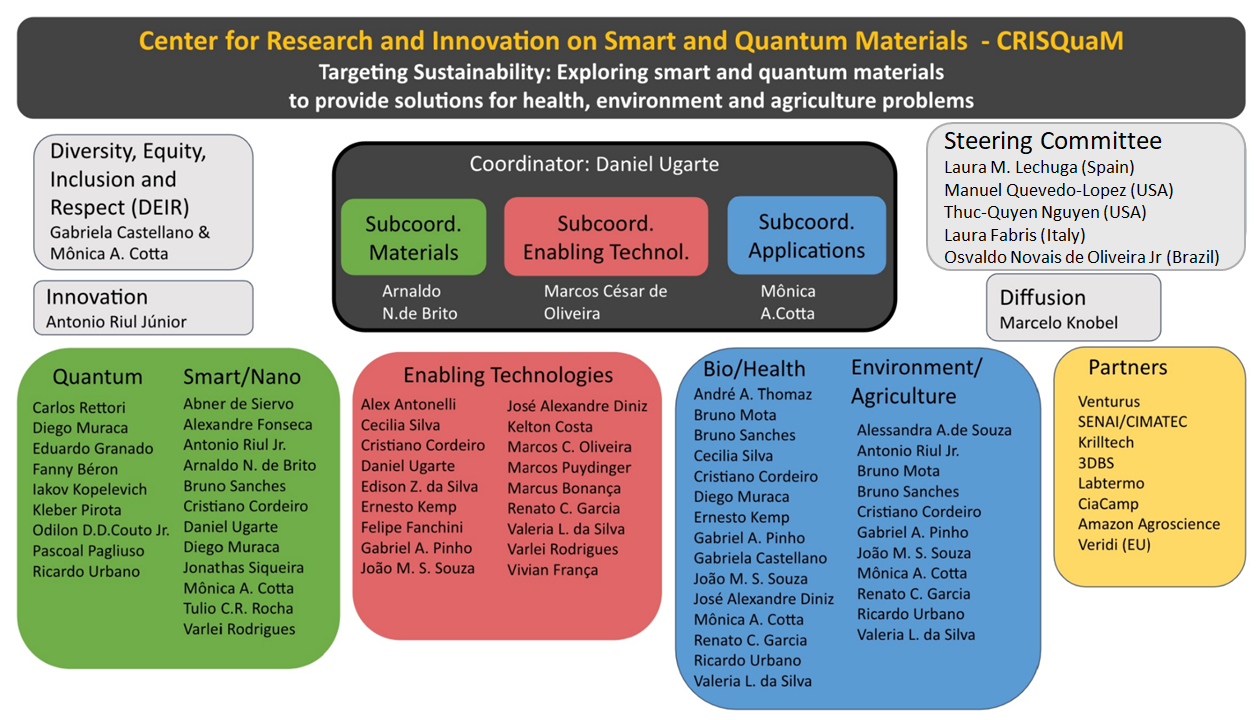BV-FAPESP: research projects supported in this Center
CRISQuaM in the Media: news about the center
CRISQuaM aims to explore the synergistic development of fundamental and applied science to create new materials with high potential for the construction of devices and sensors to address technological challenges related to sustainability, climate change, precision agriculture, ecology, and health. To achieve these goals, we have assembled an interdisciplinary and collaborative research team, integrating expertise across various scientific domains, researching novel materials with high innovation potential. By combining original synthesis methods, advanced characterization techniques, theoretical approaches, computational simulations, quantum technologies, and device construction designs, we aim to drive advances in smart and quantum materials, promoting scientific excellence and technological development. With this, we plan disruptive innovations in instrumentation—including hardware and AI-based tools—as well as in quantum technologies, biomedical devices, and signal processing, in addition to plant bionics, exploring plant-pathogen interactions. Besides research activities, we plan intensive actions in education, dissemination, and communication for the general public, as a modern society should be aware of the challenges humanity faces and how research and technology are essential for responsibly utilizing the planet's limited resources. CRISQuaM's Innovation activities are accelerated through partnerships with several companies in related technologies, many of them Brazilian. Finally, all activities of the Center are managed in accordance with diversity, equity, and inclusion goals and best practices.
The Center brings together scientists, engineers, and innovators in a collaborative effort to apply materials science and quantum technologies at the cutting edge, designing new materials and nano(bio)sensors for advanced diagnostics. The Center has a team capable of producing a wide range of (nano/micro) materials, along with precise chemical and physical characterizations using modern techniques (synchrotron, advanced microscopy, magnetotransport, magnetic resonance, optics, etc.). In addition, the team offers various options in enabling technologies, including miniaturization, processing, and additive manufacturing, as well as instrumentation, quantum sensing, and electronics development. Data analysis will employ updated approaches (numerical simulation, classical and quantum machine learning, and quantum optimization). Applications at the knowledge frontier will address urgent sustainability needs in environmental areas, precision agriculture, plant bionics, and biomedical interfaces, contributing to the development of local technologies in close partnership with the Brazilian industry.
The organization of the Center is based on three pillars — Materials, Enabling Technologies, and Applications — together with partner companies, as described in the figure below.

2025-09-15
Analysis of the interaction between ants, plants that secrete sweet substances to attract them, “interested” in defending themselves from leaf-eating animals, and bees indicates that the ants may scare away pollinators. Butterflies, on the other hand, are not bothered.
2025-09-10
Non-compliance with the law, facilitated by errors in the technical language used in environmental licensing, has already led to the loss of over 580,000 hectares of native vegetation, 61% of which has been converted for agricultural use.
2025-09-10
Bringing together studies by various experts, the book Science of Early Childhood highlights the importance of this period in people’s development and lives. It also warns of the far-reaching consequences of social inequality.
2025-09-10
A study in an animal model analyzed the muscle metabolism of guinea pigs on a high-calorie diet. Ultimately, consumption of the plant extract increased the expression of genes associated with glucose uptake and the activity of an essential metabolic enzyme.
2025-09-08
Brazilian researchers have developed a tool that can be used to improve animal welfare by assessing tambaqui fish based on the coloration of the lower half of their bodies. Brazil is the world’s largest producer of this species.